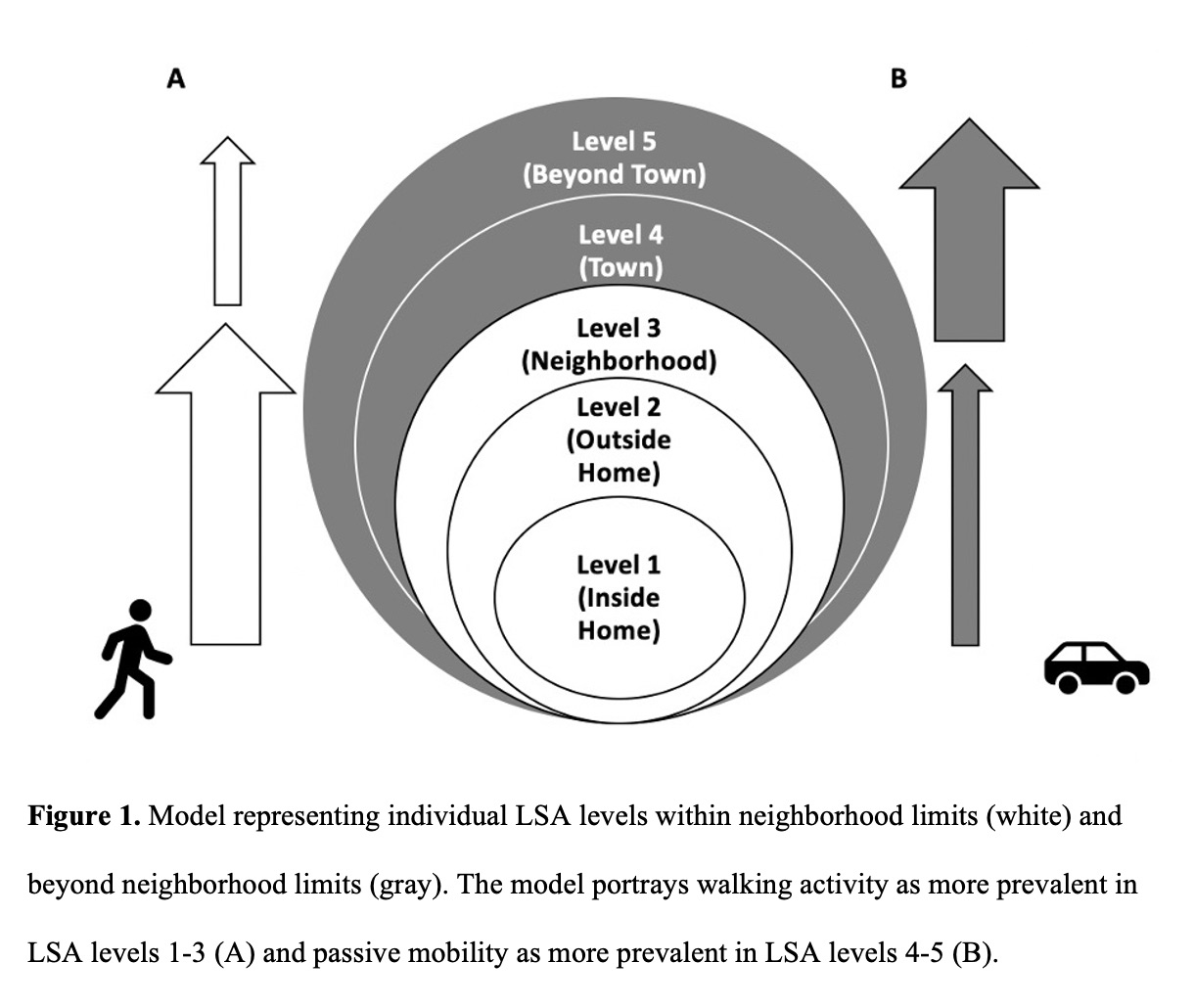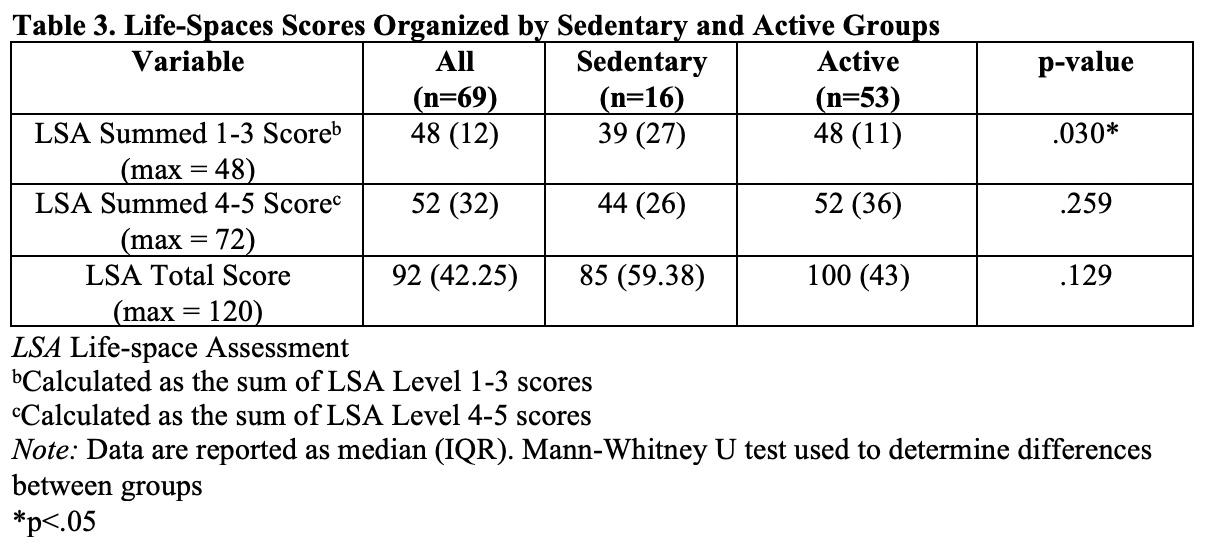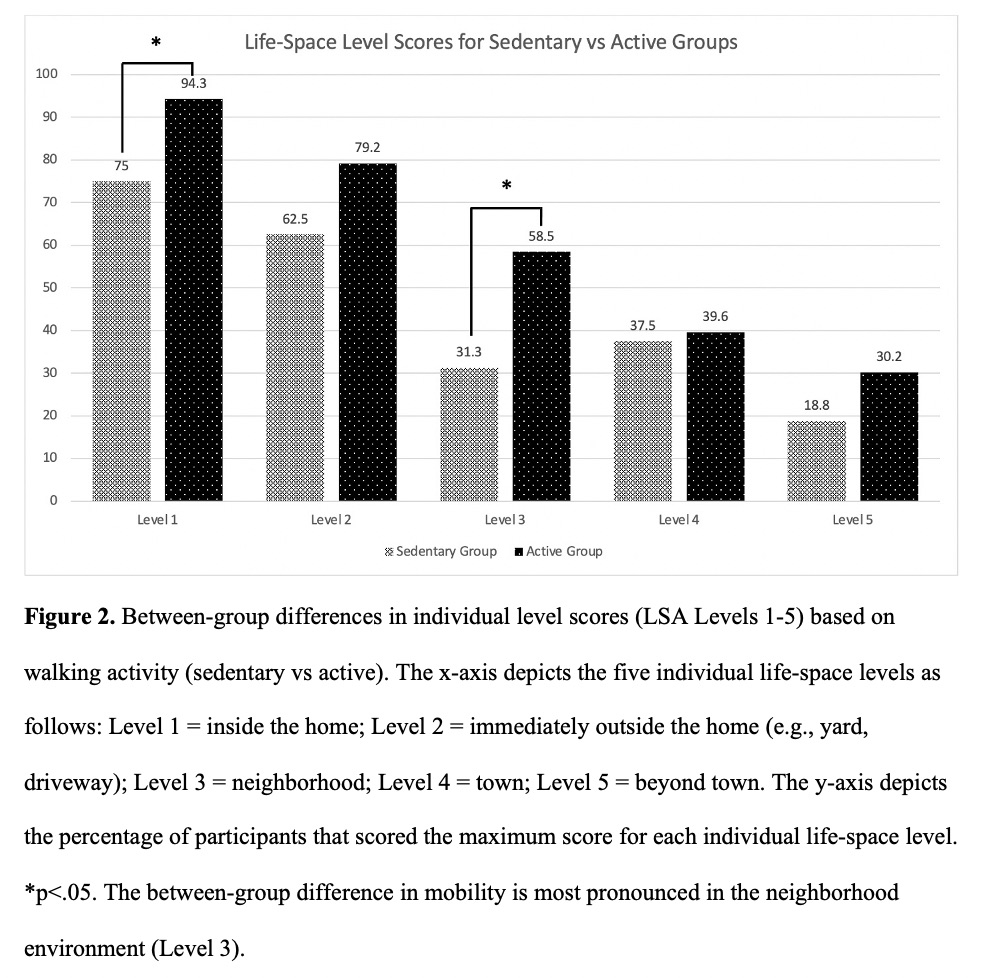Category: Parkinson’s Disease: Clinical Trials
Objective: The primary aims of this study were (1) to determine in persons with Parkinson Disease (PD) the extent to which walking activity might contribute to total life-space mobility as well as mobility occurring within and beyond neighborhood limits, and (2) to examine the relationship between walking activity and mobility at each life-space level. Our secondary aim was to explore how life-space mobility might differ in sedentary persons with PD compared to their more active counterparts [1].
Background: Walking activity in persons with PD is important for preventing functional decline [2,3]. How interventions that increase walking activity might impact home and community mobility has yet to be studied. More fundamentally, the contribution of walking activity to home and community mobility is poorly understood.
Method: Cross-sectional baseline data (n=69) were analyzed from a randomized controlled PD trial [4]. The Life-Space Assessment (LSA) assessed five expanding levels of home and community mobility, producing individual subscores and a total score [5,6]. Two additional summed scores were used to represent mobility within (Levels 1-3) and beyond (Levels 4-5) neighborhood limits [figure 1]. An accelerometer measured walking activity for seven days. Regression and correlation analyses evaluated relationships between daily steps and mobility scores. Mann-Whitney U tests secondarily compared differences in mobility scores between active and sedentary groups.
Results: Walking activity contributed significantly to the summed Level 1-3 score (=.001, p=.004) but not to the summed Level 4-5 (=.001, p=.33) or total (=.002, p=.07) scores [table 1]. Walking activity was significantly related to Level 1 (r=.336, p=.005), Level 2 (r=.307, p=.010), and Level 3 (r=.314, p=.009) subscores [table 2]. Only the summed Level 1-3 score (p=.030) was significantly different between active and sedentary groups [table 3] [figure 2].
Conclusion: Persons with PD who were more mobile were not necessarily more active. Walking activity contributed to home and neighborhood mobility moreso than beyond the neighborhood. Compared to LSA total score, the Level 1-3 summed score may be a more useful mobility measure for assessing the impact of increased walking activity.
References: [1] Tudor-Locke C, Hatano Y, Pangrazi RP, Kang M. Revisiting “how many steps are enough?” Med Sci Sports Exerc 2008;40(7)(Suppl):S537-543. [2] Ellis TD, Cavanaugh, JT, Earhart GM, Ford MP, Foreman KB, Thackeray A, Thiese MS, Dibble LE. Identifying clinical measures that most accurately reflect the progression of disability in Parkinson disease. Parkinsonism Relat Disord 2016;25:65-71. [3] Shulman LM, Gruber-Baldini AL, Anderson KE, Vaughan CG, Reich SG, Fishman PS et al. The evolution of disability in Parkinson disease. Movement Disorders. 2008;23(6):790-796. [4] Rawson KS, Cavanaugh JT, Colon-Semenza C, DeAngelis T, Duncan R, Fulford D, LaValley M, Mazzoni P, Nordahl T, Quintiliani L, Marie Saint-Hilaire, Thomas CA, Earhart GM, Ellis TD. Design of the WHIP-PD study: a phase II, twelve-month, dual-site, randomized controlled trial evaluating the effects of a cognitive-behavioral approach for promoting enhanced walking activity using mobile health technology in people with Parkinson-disease. BMC Neurology April 2020;20:146. [5] Baker PS, Bodner EV, Allman RM. Measuring life-space mobility in community-dwelling older adults. American Geriatrics Society. 2003;51:1610-1614. [6] Peel C, Baker PS, Roth DL, Brown CJ, Bodner EV, Allman RM. Assessing mobility in older adults: The UAB study of aging life-space assessment. Physical Therapy. 2005;85(10):1008-1119.
To cite this abstract in AMA style:
J. Zajac, J. Cavanaugh, T. Baker, C. Colón-Semenza, T. Deangelis, R. Duncan, D. Fulford, M. Lavalley, T. Nordahl, K. Rawson, M. Saint-Hilaire, C. Thomas, G. Earhart, T. Ellis. Are Mobile Persons with Parkinson Disease Necessarily More Active? [abstract]. Mov Disord. 2021; 36 (suppl 1). https://www.mdsabstracts.org/abstract/are-mobile-persons-with-parkinson-disease-necessarily-more-active/. Accessed December 16, 2025.« Back to MDS Virtual Congress 2021
MDS Abstracts - https://www.mdsabstracts.org/abstract/are-mobile-persons-with-parkinson-disease-necessarily-more-active/





